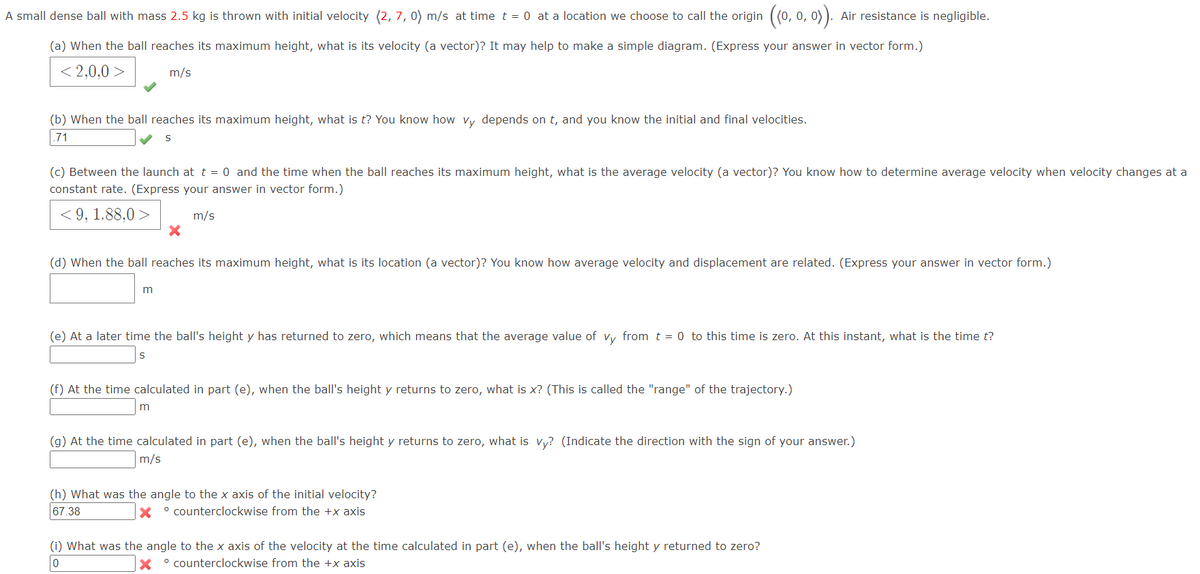Principles of Physics: A Calculus-Based Text
5th Edition
ISBN:9781133104261
Author:Raymond A. Serway, John W. Jewett
Publisher:Raymond A. Serway, John W. Jewett
Chapter3: Motion In Two Dimensions
Section: Chapter Questions
Problem 7OQ: A projectile is launched on the Earth with a certain initial velocity and moves without air...
Related questions
Question
Pls solve this question correctly instantly in 5 min i will give u 3 like for sure

Transcribed Image Text:A small dense ball with mass 2.5 kg is thrown with initial velocity (2, 7, 0) m/s at time t = 0 at a location we choose to call the origin ((0, 0, 0)). Air resistance is negligible.
(a) When the ball reaches its maximum height, what is its velocity (a vector)? It may help to make a simple diagram. (Express your answer in vector form.)
<2,0,0>
m/s
(b) When the ball reaches its maximum height, what is t? You know how vy depends on t, and you know the initial and final velocities.
.71
S
(c) Between the launch at t = 0 and the time when the ball reaches its maximum height, what is the average velocity (a vector)? You know how to determine average velocity when velocity changes at a
constant rate. (Express your answer in vector form.)
<9, 1.88,0>
m/s
X
(d) When the ball reaches its maximum height, what is its location (a vector)? You know how average velocity and displacement are related. (Express your answer in vector form.)
m
(e) At a later time the ball's height y has returned to zero, which means that the average value of vy from t = 0 to this time is zero. At this instant, what is the time t?
S
(f) At the time calculated in part (e), when the ball's height y returns to zero, what is x? (This is called the "range" of the trajectory.)
m
(g) At the time calculated in part (e), when the ball's height y returns to zero, what is vy? (Indicate the direction with the sign of your answer.)
m/s
(h) What was the angle to the x axis of the initial velocity?
67.38
Xcounterclockwise from the +x axis
(i) What was the angle to the x axis of the velocity at the time calculated in part (e), when the ball's height y returned to zero?
0
Xcounterclockwise from the +x axis
Expert Solution
This question has been solved!
Explore an expertly crafted, step-by-step solution for a thorough understanding of key concepts.
This is a popular solution!
Trending now
This is a popular solution!
Step by step
Solved in 6 steps with 1 images

Knowledge Booster
Learn more about
Need a deep-dive on the concept behind this application? Look no further. Learn more about this topic, physics and related others by exploring similar questions and additional content below.Recommended textbooks for you

Principles of Physics: A Calculus-Based Text
Physics
ISBN:
9781133104261
Author:
Raymond A. Serway, John W. Jewett
Publisher:
Cengage Learning

University Physics Volume 1
Physics
ISBN:
9781938168277
Author:
William Moebs, Samuel J. Ling, Jeff Sanny
Publisher:
OpenStax - Rice University

Principles of Physics: A Calculus-Based Text
Physics
ISBN:
9781133104261
Author:
Raymond A. Serway, John W. Jewett
Publisher:
Cengage Learning

University Physics Volume 1
Physics
ISBN:
9781938168277
Author:
William Moebs, Samuel J. Ling, Jeff Sanny
Publisher:
OpenStax - Rice University